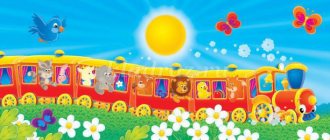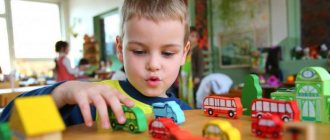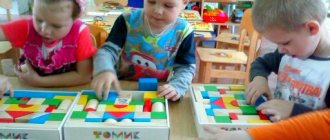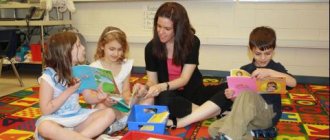Goals: 1. consolidate children's knowledge about Russian folk tales.
Objectives: Educational: 1. teach to recognize a fairy tale from illustrations, riddles; 2. strengthen children’s skills in retelling fairy tales; 3. expand your vocabulary; 4. consolidate the names of Russian folk tales; 5. teach children to analyze a fairy tale. Developmental: 1. develop children’s speech and cognitive activity, the ability to compare, generalize, draw conclusions and conclusions; 2.develop thinking, imagination, visual memory, observation. Educational: 1. cultivate interest in Russian folk tales; 2. cultivate responsiveness and a desire to help others.
Equipment: Illustrations for fairy tales, a toy mouse, pictures of transport, counting sticks, a model of a mansion, heroes of the fairy tale “Turnip” on cups, heroes of the fairy tale “Teremok”, masks - hats for dramatizing the fairy tale “Ryaba Hen”.
Preliminary work: Reading Russian folk tales, looking at illustrations, viewing the presentation “Favorite Fairy Tales”, playing games based on Russian folk tales.
GCD move
Children are included in the group. They stand in a semicircle. Educator: Guys, look, we have guests today. Let's say hello to them. Children: - Hello! Educator. Guys, look, who is crying here? (Pi - pi - pi). Yes, this is a mouse. It seems to me that she is very upset, let's listen to her and find out everything. Come here, little one. We'll feel sorry for you. Mouse. Hello guys. I'm lost and don't know where my home is, where am I from? I remember that I lived in some kind of fairy tale, but I forgot which one. Help me, please, find the fairy tale! I'm so scared, everything around me is so unfamiliar. Educator. Don't worry, mouse, we will help you. Guys, I suggest you go to a fairyland to find a fairy tale in which a mouse lives. What can you go on a trip with? (children's answers - by plane, by car, by train, by ship, by bus). Educator: I suggest you go on a journey through fairy tales on an airplane carpet. Before boarding the airplane carpet, you need to name the fairy tale from the picture.
Didactic game “Name the fairy tale”
Educator: Well done, you know fairy tales well! Go to the carpet. Music is playing. Our carpet is rushing across the sky. What will happen to us? Close your eyes quickly to find yourself in a fairy tale!
First stop: the fairy tale “Turnip”
Educator: Guys, there is a river ahead, how can we get across the river? (children's answers: on a boat, on a ship...). Educator: Guys, we are in a fairyland, let's cast a spell and a miracle will happen.
Finger gymnastics “Fairy Tales”.
A bridge appeared on the river. Children take turns crossing the river on the bridge. Educator: What fairy tale have we found ourselves in? (slide 1 – fairy tale “Turnip”). Educator: Who came first to pull the turnip? (children's answers - grandfather). Who came last to pull the turnip? (children's answers - mouse). Who came for grandma to pull the turnip? (children's answers - granddaughter). Who came to pull the turnip before the mouse? (children's answers - cat). How many people pulled the turnip? (children’s answers: three). How many animals pulled the turnip? (children’s answers: three). Educator: Guys, you completed all the tasks! Mouse, maybe this is your fairy tale? Mouse: No, this is not my fairy tale! (the mouse is upset). Educator: Don’t worry, mouse, the children will definitely help you. Educator: Oh, there’s a swamp ahead. We need to get over the bumps, then we will find ourselves in the next fairy tale. (children take turns walking over the bumps).
Second stop: The fairy tale “Teremok”
Educator: Guys, look, we have come to some kind of fairy tale. (slide 2 – fairy tale “Teremok”). Educator: Children, what fairy tale have we found ourselves in? (children's answers - “Teremok”) Educator: What did the animals ask in the fairy tale “Teremok” before entering there? (children's answers - who, who lives in the little house?) Count how many animals came to the little house? (children’s answers: five). What animal is missing? (children's answers - the bear) Guys, what happened to the tower when the bear came? (children's answers - the tower was broken). What happened to the animals? (children's answers - they ran away). Guys, what time of year is it now? (children's answers - spring). Educator: In the spring, wild animals give birth to cubs. There is nowhere for them to hide from the rain and wind. Let's build them houses.
Didactic game “Build a house”
(Children use counting sticks to build houses.) Educator: The houses turned out good. Do you want to know who will live in your houses?
Didactic game “Name the nickname of the fairy-tale hero”
The frog is a frog. Bunny is a runaway. Foxy - sister. Wolf - a gray side top. The mouse is a bitch. Educator: Mouse, is this your fairy tale? Mouse: No, and this is not my fairy tale! Educator: Guys, the mouse is very tired, let's rest.
Physical exercise “Favorite fairy tales”
So we planted it and watered it with water. The turnip grew good and strong. Now let’s pull it and cook porridge from the turnip. And from the turnip we will be healthy and strong.
The mouse ran quickly The mouse wagged its tail Oh, I dropped the egg Look, it broke.
Mouse: I remembered, I remembered! This is my fairy tale, I live here. (slide 3 – fairy tale “Ryaba Hen”).
Third stop: The fairy tale “Ryaba Hen”
Educator: Guys, what is the name of the fairy tale in which the mouse lives? (children’s answers: “Ryaba the Hen”). Educator. Don't worry, mouse, sit down and see how the fairy tale ends.
Dramatization of the fairy tale “Ryaba Hen”
Mouse: Thank you guys for finding my fairy tale! Goodbye! Educator: So our journey through fairy tales has ended. Walk onto the carpet - an airplane. It's time for us to go back to kindergarten. Music is playing. Our carpet rushes across the sky so that we can return home.
Summary of an integrated lesson in the 2nd junior group according to the Federal State Educational Standard
Summary of an integrated lesson in the 2nd junior group.
“Mashenka and the Bear” Educational areas: Cognition (FEMP, natural science) Society (fundamentals of ecology) Objectives: To develop in children a cognitive interest in the life of the forest and its inhabitants; Enrich vocabulary, develop oral speech, fine motor skills, memory, thinking, attention; Consolidate children’s knowledge about vegetables and fruits and berries, name them correctly, classify them and use the general concepts “vegetables”, “fruits” or “berries”; Form an idea of the features of appearance, where they grow; Continue to teach children to establish equality and inequality between objects, using in speech the expressions: more, less, equally; Expand children's horizons and understanding of the medical profession. Equipment: Toys:
doll Masha, soft toys of a bear, a bunny, a squirrel, a wolf, a doctor’s suitcase, pictures of a vegetable garden and object pictures (or dummies) of vegetables and fruits, models of “Borsch” and “Compote” pots, nuts for squirrels.
Progress of the lesson:
Educator: The guys came to visit us today Mashenka and the bear. Let's say hello to them. A bear toy and a Masha doll come out. Greet the children. Educator: Bear lives in a house, and near the house he has a garden and a vegetable garden. He's getting ready to plant a vegetable garden and doesn't remember what's growing in the garden and what's in the vegetable garden? Let's help him. D/Game “What Grows Where” Children are divided into two teams: gardeners and vegetable growers. At the signal, each team must collect their items. Educator: Mishka was so happy guys that you helped him. Look what carrots grew in the bear's garden. A bunny toy appears. Oh look, a bunny has come running, let's jump like bunnies. What does a bunny like to eat? That's right, carrots. Let's treat the bunny. Our bear is kind and not at all greedy; he allowed the bunny to take three large carrots. But the bunny does not know how to count and cannot distinguish a large carrot from a small one. He asks us to help him collect the biggest carrot. One of the children, if desired, collects and all together count so that there are 3 carrots. Equipment:
Imitation of a garden bed and carrots made of cardboard of different sizes.
The bunny thanks the children for their help and runs away. Educator: The vegetables are ripe in the garden, and the berries are ripe in the garden. Mashenka decided to prepare lunch for the bear and mixed everything up. Now she needs help figuring out what to make borscht from and what compote to use. D/game “Let’s cook borscht and compote” At the request of the children or at the choice of the teacher, 2 children are selected. One prepares borscht, the other compote. They tell you what they cook from and why. Educator: After a delicious lunch, Mishka and Masha like to play. Do you want to play with the bear too? Outdoor game “The bear walked through the forest” Children sit on chairs. One child portrays a bear. The bear was walking through the forest, The bear child is walking, collecting The bear was collecting pine cones. cones, and then sits on a chair. Our bear walked for a long time. and falls asleep. Mishutka sat down and dozed off. The teacher and children quietly approach the bear. The children began to come up and wake up Mishenka themselves: “Misha, Mishenka, get up and catch up with the kids.” The children run to their places, and the bear catches up with them. Educator: A squirrel lives in the forest with a bear. A toy squirrel appears. Do you know where the squirrel lives? Children's answers: on a tree. Educator: What does the squirrel like to eat? That's right, nuts. Let's tell a poem about a squirrel. Finger gymnastics. A squirrel sits on a cart, she sells nuts: (we bend our fingers) to the little fox-sister, to the sparrow, to the titmouse, to the fat-fifted bear, to the mustachioed bunny. Educator: Look, guys, how many nuts does the squirrel have? Children's answers: a lot. How much does the bear have? Children's answers: none. The squirrel shared with the bear and gave him one nut. Who has more nuts? Children's answers: at the bear. The squirrel gave the bear one more nut, and now how many nuts does he have? Children's answers: the same amount as the squirrel, equally. Squirrel says goodbye and leaves. Educator: Guys, Masha wants to introduce us to someone. The appearance of a wolf toy with a suitcase. Educator: Do you know who the wolf works in the forest? He is a doctor, he treats forest animals. The wolf asks us for help, we need to sort through his things in his suitcase and put there only those things that he needs to treat the animals. The things from the suitcase are laid out on the table. Children choose the items they need one by one. The wolf thanks everyone for their help and says goodbye. Masha and the bear remember that they still have a lot to do in the forest. They say goodbye to the children and leave. Educator: Guys, who came to visit us today? Children list animals. You enjoyed playing with them and helping them. Children remember how and whom they helped.
We recommend watching:
Summary of a comprehensive lesson in the second junior group. Getting to know the dog
Similar articles:
Summary of lessons in kindergarten in the 2nd junior group. Group room
Summary of a game development lesson in kindergarten in the second group of early age on the topic: Animals
Summary of a lesson in the junior group of kindergarten on the topic: “Human nutrition”
Summary of a lesson in the junior group of kindergarten on the topic: “Mood”
Lesson notes about kindergarten. Junior group




